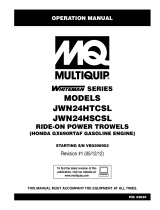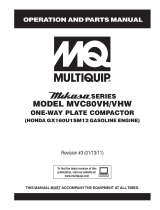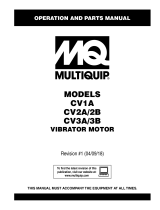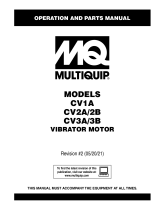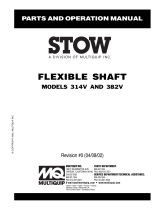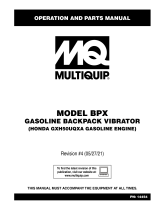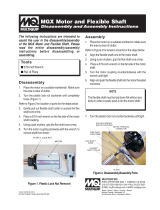Page is loading ...

OperatiOn and parts Manual
THIS MANUAL MUST ACCOMPANY THE EQUIPMENT AT ALL TIMES.
To find the latest revision of this
publication, visit our website at:
www.multiquip.com
MOdels
Cv1a
Cv2a/2B
Cv3a/3B
viBratOr MOtOr
Revision #0 (04/30/13)

PAGE 2 — CV SERIES VIBRATOR MOTOR • OPERATION AND PARTS MANUAL — REV. #0 (04/30/13)
Grinding/cutting/drilling of masonry, concrete, metal and
other materials with silica in their composition may give
off dust or mists containing crystalline silica. Silica is a
basic component of sand, quartz, brick clay, granite and
numerous other minerals and rocks. Repeated and/or
substantial inhalation of airborne crystalline silica can
cause serious or fatal respiratory diseases, including
silicosis.In addition, California and some other
authorities have listed respirable crystalline silica as a
substance known to cause cancer. When cutting such
materials, always follow the respiratory precautions
mentioned above.
WARNING
Grinding/cutting/drilling of masonry, concrete, metal and
other materials can generate dust, mists and fumes
containing chemicals known to cause serious or fatal
injury or illness, such as respiratory disease, cancer,
birth defects or other reproductive harm. If you are
unfamiliar with the risks associated with the particular
process and/or material being cut or the composition of
the tool being used, review the material safety data
sheet and/or consult your employer, the material
manufacturer/supplier, governmental agencies such as
OSHA and NIOSH and other sources on hazardous
materials. California and some other authorities, for
instance, have published lists of substances known to
cause cancer, reproductive toxicity,or other harmful
effects.
Control dust, mist and fumes at the source where
possible. In this regard use good work practices and
follow the recommendations of the manufacturers or
suppliers, OSHA/NIOSH, and occupational and trade
associations.Water should be used for dust
suppression when wet cutting is feasible. When the
hazards from inhalation of dust, mists and fumes cannot
be eliminated, the operator and any bystanders should
always wear a respirator approved by NIOSH/MSHA for
the materials being used.
WARNING
SILICOSIS WARNING RESPIRATORY HAZARDS
SILICOSIS/RESPIRATORY WARNINGS

CV SERIES VIBRATOR MOTOR • OPERATION AND PARTS MANUAL — REV. #0 (04/30/13) — PAGE 3
NOTES

PAGE 4 — CV SERIES VIBRATOR MOTOR • OPERATION AND PARTS MANUAL — REV. #0 (04/30/13)
TABLE OF CONTENTS
CVS Series Vibrator Motor
Silicosis/Respiratory Warnings ................................ 2
Table Of Contents .................................................... 4
Parts Ordering Procedures ...................................... 5
General Power Tool Safety Warnings ................... 6-7
Noise and Vibration Figures .................................... 8
Safety Information .............................................. 9-12
Specifications ........................................................ 13
Dimensions ............................................................ 14
General Information .......................................... 15-16
Setup ................................................................ 17-18
Operation ............................................................... 19
Maintenance ..................................................... 20-22
Troubleshooting ..................................................... 23
Explanation Of Code In Remarks Column............. 24
Component Drawings
Decals ............................................................... 26-27
Vibrator Motor Housing Assembly .................... 28-29
Vibrator Motor Assembly. .................................. 30-31
Terms And Conditions Of Sale — Parts ................ 32
NOTICE
Specifications and part numbers are subject to change
without notice.

CV SERIES VIBRATOR MOTOR • OPERATION AND PARTS MANUAL — REV. #0 (04/30/13) — PAGE 5
PARTS ORDERING PROCEDURES
www.multiquip.com
Ordering parts has never been easier!
Choose from three easy options:
WE ACCEPT ALL MAJOR CREDIT CARDS!
When ordering parts, please supply:
❒ Dealer Account Number
❒ Dealer Name and Address
❒ Shipping Address (if different than billing address)
❒ Return Fax Number
❒ Applicable Model Number
❒ Quantity, Part Number and Description of Each Part
❒ Specify Preferred Method of Shipment:
✓ UPS/Fed Ex ✓ DHL
■ Priority One ✓ Tr uck
■ Ground
■ Next Day
■ Second/Third Day
If you have an MQ Account, to obtain a Username
and Password, E-mail us at:
parts@multiquip.
com.
To obtain an MQ Account, contact your
District Sales Manager for more information.
Order via Internet (Dealers Only):
Order parts on-line using Multiquip’s SmartEquip website!
■ View Parts Diagrams
■ Order Parts
■ Print Specifi cation Information
Note: Discounts Are Subject To Change
Goto www.multiquip.com and click on
Order Parts
to log in and save!
Use the internet and qualify for a 5% Discount
on Standard orders for all orders which include
complete part numbers.*
Order via Fax (Dealers Only):
All customers are welcome to order parts via Fax.
Domestic (US) Customers dial:
1-800-6-PARTS-7 (800-672-7877)
Fax your order in and qualify for a 2% Discount
on Standard orders for all orders which include
complete part numbers.*
Order via Phone:
Domestic (US) Dealers Call:
1-800-427-1244
Best Deal!
International Customers should contact
their local Multiquip Representatives for
Parts Ordering information.
Non-Dealer Customers:
Contact your local Multiquip Dealer for
parts or call 800-427-1244 for help in
locating a dealer near you.
Note: Discounts Are Subject To Change
Effective:
January 1
st
, 2006
NOTICE
All orders are treated as Standard Orders and will
ship the same day if received prior to 3PM PST.

PAGE 6 — CV SERIES VIBRATOR MOTOR • OPERATION AND PARTS MANUAL — REV. #0 (04/30/13)
GENERAL POWER TOOL SAFETY WARNINGS
WARNING Read all safety warnings and all instructions. Failure to follow the warnings and instructions may result
in electric shock, fire and/or serious injury.
Save all warnings and instructions for future reference.
The term "power tool" in the warnings refers to your mains-operated (corded) power tool or battery-operated (cordless)
power tool.
1. Work area safety
a) Keep work area clean and well lit. Cluttered or dark areas invite accidents.
b) Do not operate power tools in explosive atmospheres, such as in the presence of flammable liquids, gases
or dust. Power tools create sparks which may ignite the dust or fumes.
c) Keep children and bystanders away while operating a power tool. Distractions can cause you to lose control.
2. Electrical safety
a) Power tool plugs must match the outlet. Never modify the plug in any way. Do not use any adapter plugs
with earthed (grounded) power tools. Unmodified plugs and matching outlets will reduce risk of electric shock.
b) Avoid body contact with earthed or grounded surfaces such as pipes, radiators, ranges and refrigerators.
There is an increased risk of electric shock if your body is earthed or grounded.
c) Do not expose power tools to rain or wet conditions. Water entering a power tool will increase the risk of
electric shock.
d) Do not abuse the cord. Never use the cord for carrying, pulling or unplugging the power tool. Keep cord away
from heat, oil, sharp edges or moving parts. Damaged or entangled cords increase the risk of electric shock.
e) When operating a power tool outdoors, use an extension cord suitable for outdoor use. Use of a cord
suitable for outdoor use reduces the risk of electric shock.
f) If operating a power tool in a damp location is unavoidable, use a residual current device (RCD), or Ground
fault circuit interrupter (GFCI) protected supply. Use of an RCD or GFCI reduces the risk of electric shock.
3. Personal safety
a) Stay alert, watch what you are doing and use common sense when operating a power tool. Do not use a
power tool while you are tired or under the influence of drugs, alcohol or medication. A moment of inattention
while operating power tools may result in serious personal injury.
b) Use personal protective equipment. Always wear eye protection. Protective equipment such as dust mask,
non-skid safety shoes, hard hat, or hearing protection used for appropriate conditions will reduce personal injuries.
c) Prevent unintentional starting. Ensure the switch is in the off-position before connecting to power source
and/or battery pack, picking up or carrying the tool. Carrying power tools with your finger on the switch or
energizing power tools that have the switch on invites accidents.
d) Remove any adjusting key or wrench before turning the power tool on. A wrench or a key left attached to a
rotating part of the power tool may result in personal injury.
e) Do not overreach. Keep proper footing and balance at all times. This enables better control of the power tool
in unexpected situations.

CV SERIES VIBRATOR MOTOR • OPERATION AND PARTS MANUAL — REV. #0 (04/30/13) — PAGE 7
GENERAL POWER TOOL SAFETY WARNINGS
f) Dress properly. Do not wear loose clothing or jewelry. Keep your hair, clothing and gloves away from
moving parts. Loose clothes, jewelry or long hair can be caught in moving parts.
g) If devices are provided for the connection of dust extraction and collection facilities, ensure these are
connected and properly used. Use of dust collection can reduce dust-related hazards.
4. Power tool use and care
a) Do not force the power tool. Use the correct power tool for your application. The correct power tool will do
the job better and safer at the rate for which it was designed.
b) Do not use the power tool if the switch does not turn it on and off. Any power tool that cannot be controlled
with the switch is dangerous and must be repaired.
c) Disconnect the plug from the power source and/or the battery pack from the power tool before making
any adjustments, changing accessories, or storing power tools. Such preventive safety measures reduce the
risk of starting the power tool accidentally.
d) Store idle power tools out of the reach of children and do not allow persons unfamiliar with the power tool
or these instructions to operate the power tool. Power tools are dangerous in the hands of untrained users.
e) Maintain power tools. Check for misalignment or binding of moving parts, breakage of parts and any other
condition that may affect the power tool's operation. If damaged, have the power tool repaired before use.
Many accidents are caused by poorly maintained power tools.
f) Keep cutting tools sharp and clean. Properly maintained cutting tools with sharp cutting edges are less likely
to bind and are easier to control.
g) Use the power tool, accessories and tool bits etc. in accordance with these instructions, taking into account
the working conditions and the work to be performed. Use of the power tool for operations different from those
intended could result in a hazardous situation.
5. Service
a) Have your power tool serviced by a qualified repair person using only identical replacement parts. This
will ensure that the safety of the power tool is maintained.

PAGE 8 — CV SERIES VIBRATOR MOTOR • OPERATION AND PARTS MANUAL — REV. #0 (04/30/13)
NOISE AND VIBRATION FIGURES
Noise Emissions
It is recommended the operator wear hearing protection while operating the power tool.
Sound pressure level at the work station: L
pA
= 82.5 dB (in accordance with EN ISO 11203)
Sound pressure level: L
WA
= 93.5 dB (in accordance with EN ISO 3744)
Vibration Emissions
Vibration Emissions Value = 1.23 m/s²
Uncertainty = 1.5 m/s²
The declared vibration total value has been measured in accordance with a standard test method (EN 60745-2-12; 2009
6.2.6.3) and may be used for comparing one tool with another.
The declared vibration total value may also be used in a preliminary assessment of exposure.
Warning!
The vibration emission during actual use of the power tool can differ from the declared total value depending on the ways
in which the tool is used.
Identify safety measures to protect the operator that are based on an estimation of exposure in the actual conditions
of use (taking account of all parts of the operating cycle such as the times when the tool is switched off and when it is
running idle in addition to the trigger time).

CV SERIES VIBRATOR MOTOR • OPERATION AND PARTS MANUAL — REV. #0 (04/30/13) — PAGE 9
SAFETY INFORMATION
Do not operate or service the equipment before reading
the entire manual. Safety precautions should be followed
at all times when operating this equipment.
Failure to read and understand the safety
messages and operating instructions could
result in injury to yourself and others.
SAFETY MESSAGES
The four safety messages shown below will inform you
about potential hazards that could injure you or others. The
safety messages specifi cally address the level of exposure
to the operator and are preceded by one of four words:
DANGER, WARNING, CAUTION
or NOTICE.
SAFETY SYMBOLS
DANGER
Indicates a hazardous situation which, if not avoided,
WILL result in DEATH or SERIOUS INJURY.
WARNING
Indicates a hazardous situation which, if not avoided,
COULD result in DEATH or SERIOUS INJURY.
CAUTION
Indicates a hazardous situation which, if not avoided,
COULD result in MINOR or MODERATE INJURY.
NOTICE
Addresses practices not related to personal injury.
Potential hazards associated with the operation of this
equipment will be referenced with hazard symbols which
may appear throughout this manual in conjunction with
safety messages.
Burn hazards
Symbol Safety Hazard
Electric shock hazards
Earth Ground
Protected against splashing
water
IPX-4
To reduce risk of injury user
must read instruction manual

PAGE 10 — CV SERIES VIBRATOR MOTOR • OPERATION AND PARTS MANUAL — REV. #0 (04/30/13)
SAFETY INFORMATION
GENERAL SAFETY
CAUTION
NEVER operate this equipment without proper protective
clothing, shatterproof glasses, respiratory protection,
hearing protection, steel-toed boots and other protective
devices required by the job or city and state regulations.
Avoid wearing jewelry or loose fi tting clothes that may
snag on the controls or moving parts as this can cause
serious injury.
NEVER operate this equipment when not
feeling well due to fatigue, illness or when
under medication.
NEVER operate this equipment under the
infl uence of drugs or alcohol.
ALWAYS clear the work area of any debris, tools, etc.
that would constitute a hazard while the equipment is
in operation.
Keep work area well lit.
No one other than the operator is to be in the working
area when the equipment is in operation.
DO NOT use the equipment for any purpose other than
its intended purposes or applications.
NOTICE
This equipment should only be operated by trained and
qualifi ed personnel 18 years of age and older.
Whenever necessary, replace nameplate, operation and
safety decals when they become diffi cult read.
Manufacturer does not assume responsibility for any
accident due to equipment modifi cations. Unauthorized
equipment modifi cation will void all warranties.
NEVER
use accessories or attachments that are not
recommended by Multiquip for this equipment. Damage
to the equipment and/or injury to user may result.
ALWAYS know the location of the nearest
fi re extinguisher.
ALWAYS know the location of the nearest
fi rst aid kit.
ALWAYS know the location of the nearest phone or
keep
a phone on the job site.
Also, know the phone numbers
of the nearest ambulance, doctor and
fi re department.
This information will be invaluable in the case of an
emergency.

CV SERIES VIBRATOR MOTOR • OPERATION AND PARTS MANUAL — REV. #0 (04/30/13) — PAGE 11
SAFETY INFORMATION
VIBRATOR MOTOR SAFETY
DANGER
ALWAYS wear rubber insulated gloves and boots when
holding the fl exshaft during operation. The possibility of
electrocution exists causing equipment damage and
severe bodily harm even death!
DANGER
If applicable, periodically check insulation resistance
as referenced in maintenance section. The possibility
of electrocution exists causing equipment damage and
severe bodily harm even death!
WARNING
NEVER attempt to run the core outside the casing
assembly for any reason.
CAUTION
DO NOT overreach. Keep proper footing and balance at
all times.
DO NOT carry plugged-in motor with fi nger on the switch.
NEVER carry the motor by the cord. Use the carrying
handle.
ALWAYS check the vibrator motor for loosened hardware
such as nuts and bolts before starting.
Keep the cord from heat, oil, and sharp objects.
DO NOT overload the motor. It will do a better and safer
job at the rate for which it was designed.
DO NOT expose vibrator motor to rain.
DO NOT use vibrator motor in damp or wet locations
without proper electrical circuits.
ALWAYS keep clear of rotating or moving parts while
operating the vibrator motor.
NEVER leave the machine unattended while running..
ALWAYS disconnect the motor from the power source
when not in use, before servicing, and when changing
fl exible shafting and vibrator heads.
Allow the vibrator motor to cool before
servicing. Contact with hot components can
cause serious burns.
Before each use, ALWAYS check the motor
to make certain that there are no damaged parts and that
all parts function properly (such as switch, cord housing).
If any damage or malfunctioning parts are found, have
them repaired or replaced by an authorized service facility.
NOTICE
Secure forms. Make sure the form work is well made and
braced to withstand the stresses made by vibration.
Keep vibrator motor clean for better and safer operation.
ALWAYS
store equipment properly when it is not being
used. Equipment should be stored in a clean, dry location
out of the reach of children and unauthorized personnel.
Use only factory-authorized replacement parts.
Store idle vibrator motor. When not in use, motor should
be stored in a dry, safe storage area.
ELECTRICAL SAFETY
CAUTION
Prevent body contact with grounded surfaces such as
pipes, reinforcing bar, etc.
When applicable, use a protection wiring device, such
as a Ground Fault Circuit Interrupter, for the protection
of personnel.
Operate electric motor only at the specifi ed voltage
indicated on the nameplate.
DO NOT spray water onto electric motor.
DO NOT
yank the cord to disconnect it from the
receptacle. Grasp the plug itself to disconnect it.
ALWAYS
make sure the ON/OFF switch on the electric
motor is in the OFF position when not in use and before
inserting the power plug into an AC receptacle.

PAGE 12 — CV SERIES VIBRATOR MOTOR • OPERATION AND PARTS MANUAL — REV. #0 (04/30/13)
SAFETY INFORMATION
Before plugging the motor into a power source, ALWAYS
remove any wrenches or other tools from the motor,
shaft, and head that were used for assembly.
Power Cord/Cable Safety
DANGER
ALWAYS use a grounded 3-wire extension cord that has
a 3-prong grounding plug, and a 3-pole receptacle that
accepts the plug on the concrete vibrator motor. DO NOT
REMOVE THE GROUNDING PIN FROM THE PLUG!
NEVER let power cords or cables lay in water.
NEVER use damaged or worn cables or cords when
connecting equipment to generator. Inspect for cuts in
the insulation.
NEVER grab or touch a live power
cord or cable with wet hands. The
possibility exists of electrical shock,
electrocution or death.
Make sure power cables are securely connected.
Incorrect connections may cause electrical shock and
damage to the vibrator motor.
CAUTION
Ensure that cables and cords will not be tripped over.
NOTICE
ALWAYS make certain that proper power or extension
cord has been selected for the job.
Use only extension cords that are intended for outdoor
use and so marked.
Use only the gauge wire and length of cord recommended
for the motor size. If in doubt, go to the next heavier gauge.
(The smaller the gauge number, the heavier the cord.)
ENVIRONMENTAL SAFETY/DECOMMISSIONING
NOTICE
DO NOT
pour waste or oil directly onto the ground, down
a drain or into any water source.
Contact your country's Department of Public Works or
recyling agency in your area and arrange for proper
disposal of any electrical components, waste or oil
associated with this equipment.
When the life-cycle of this equipment is
over it is recommended that the head
casing and all other metal parts be sent
to a recycling center.

CV SERIES VIBRATOR MOTOR • OPERATION AND PARTS MANUAL — REV. #0 (04/30/13) — PAGE 13
SPECIFICATIONS
Table 1. Vibrator Motor Specifications
Model#
CV1A CV2A CV2B CV3A CV3B
Horsepower 1 HP (0.746 kW) 2 HP (1.492 kW) 3 HP (2.238 kW)
Weight 11 lbs (4989.5 g) 12.5 lbs (5669.9 g) 13.5 lbs (6123.5 g)
RPM (No Load) 22,000 RPM
Volts 115 VAC 115 VAC 230 VAC 115 VAC 230 VAC
Amps 10A 15 A 7.5 A 20 A 10 A
Hertz 50/60 Hz
Table 2. Drive Motors
Model# Amps Voltage/Frequency HP (kW) RPM
Required
Shaft
Type
CV1A 10 115 VAC 50/60 Hz 1 (1.2) 16,000 FSN Electric
CV2A 15 115 VAC 50/60 Hz 2 (1.8) 18,000 FS Electric
CV2B 7.5 230 VAC 50/60 Hz 2 (1.8) 18,000 FS Electric
CV3A 20 115 VAC 50/60 Hz 3 (2.4) 19,250 FS Electric
CV3B 10 230 VAC 50/60 Hz 3 (2.4) 19,250 FS Electric

PAGE 14 — CV SERIES VIBRATOR MOTOR • OPERATION AND PARTS MANUAL — REV. #0 (04/30/13)
DIMENSIONS
Table 3. Dimensions
Model CV1A CV2A CV2B CV3A CV3B
Length 13.5 inches (343 mm) 13.5 inches (343 mm) 13.5 inches (343 mm)
Width 8.75 inches (222.25 mm) 8.75 inches (222.25 mm) 8.75 inches (222.25 mm)
Height 7.75 inches (196.85 mm) 7.75 inches (196.85 mm) 7.75 inches (196.85 mm)
Figure 1. Dimensions
W L
H

CV SERIES VIBRATOR MOTOR • OPERATION AND PARTS MANUAL — REV. #0 (04/30/13) — PAGE 15
GENERAL INFORMATION
Multiquip's CV Series Vibrator Motors are designed to
work with flex shafts and vibrator heads for consolidation
of fresh concrete to ensure optimum strength and durability.
See Table 2 for the required shafts for the different vibrator
motor models.
These vibrator motors have large vibration-isolated handles
to protect the motor and the operator. They have a quick-
disconnect knob for easy shaft removal.
The cassette-style motor improves durability and
performance by minimizing friction and enabling the motor
to maintain optimum RPM.
The flow-through ventilation feature of these motors
reduces contamination by taking in air from the rear of
the motor.
FLEXIBLE SHAFTS
Multiquip's flex-shafts vibrator heads are designed to work
in medium to high slump concrete. Typical applications
include small pours, slabs, driveways, stem walls and
footings.
Typical shaft lengths range from 2 to 21 feet (0.6 to
6.4 meters). See Table 6 for recommended shaft lengths.
Steel heads, attached to one end of the flex-shaft, generate
vibration via an eccentric rotator that consolidates the
concrete by removing air pockets. The round head design
allows for the transmission of vibration in all directions.
There are 7 different steel head sizes that range from
7
/
8
to 2
5
/
8
inches in diameter. Typical vibration frequency for
these vibrating heads range from 9,200 to 12,150 VPM
with 1-inch slump when using electric motors.
CONSOLIDATION
Consolidation eliminates pockets of air bubbles maximizing
strength and eliminating voids. Vibrators consolidate
concrete by transmitting shock waves which allow the
aggregate to float freely while pushing lighter trapped air
up and out of the concrete mix.
A properly consolidated concrete pour will display a thin line
of mortar appearing along the form near the vibrator and the
coarse aggregate has been dispersed evenly throughout
the pour and is not visible.
VIBRATION TIME
Vibration time depends on frequency. The higher the
frequency, the less vibration time is required for the job.
VIBRATION RANGE
Vibration range (Figure 2) can be defined as "Area of
Influence". This area of influence (vibrating radius) is the
distance from the center of the vibrator to the outer most
edge.
Figure 2. Vibrator Radius/Spacing
Table 4 shows the vibration radius and spacing for a given
vibrator head diameter.
R
AREA
OF INFLUENCE
(VIBRATING RADIUS)
VIBRATOR HEAD
INSERTION SPACING
D
Table 4. Vibrating Radius/Insertion Spacing
Vibrating
HD. Model
Vibrator HD.
Dia. in. (mm)#
Vibration
Radius (R)
Vibrator
Spacing (D)
900HD
7
/
8
(22) 4 (102) 6 (152)
1000HD 1
1
/
16
(27) 5.5 (140) 8.25 (210)
1400HD 1
3
/
8
(35) 8 (203) 12 (305)
1700HD 1
11
/
16
(43) 12 (305) 18 (457)
2100HD 2
1
/
8
(54) 14 (356) 21 (533)
2600HD 2
5
/
8
(67) 18 (457) 27 (686)
NOTICE
Radius (area of influence R) and vibrator head spacing
(D) are expressed in inches/millimeters. Radius and
distance values expressed in Table 4 are only to be
used as a general guide. Values are subject to change.

PAGE 16 — CV SERIES VIBRATOR MOTOR • OPERATION AND PARTS MANUAL — REV. #0 (04/30/13)
GENERAL INFORMATION
When determining which head to choose it is important
to access the application; mainly the dimensions of the
application. Select the vibrator head based on its radiating
radius characteristics. Refer to Table 4.
Select the vibrating head that covers the largest possible
area without excessive overkill. This will allow for more
efficient productivity. General rule of thumb is: DO NOT
select a vibrator head which has a vibration radius of more
than twice the width of the form.
Example:
If the form width is 9 inches (229 mm) the selected vibrator
head radius should not exceed an 18 inch (457 mm) radius.
In this example the 2600HD vibrator head would be the
recommended choice. Refer to Table 4 and Figure 3.
Figure 3. Head Selection
NOTICE
Vibrator head spacing distance (D) is calculated by
multiplying the vibrating head radius (area of influence)
by 1.5.
AREA OF INFLUENCE
(VIBRATING RADIUS)
VIBRATOR HEAD
INSERTION SPACING
VIBRATOR HEAD
INSERTION POINT
CONCRETE
TOO SMALL AREA
OF INFLUENCE
(VIBRATING RADIUS)
NO VIBRATION
NO VIBRATION
CORRECT
FORM
WIDTH
EXTENSION CORDS
When extension cords are used, refer toTable 5 for the
correct size and lengths needed. Using an extension
cord with a wire gauge smaller than or longer than
the recommended size could result in reduced motor
performance and/or damage to the motor or extension
cord due to overheating.
Table 5. Extension Cord Sizes (AWG)
Ampere
Rating
Range
Volts Length of Cord in Feet
115V 25 ft. 50 ft. 100 ft. 150 ft. 200 ft. 250 ft.
230V 50 ft. 100 ft. 200 ft. 300 ft. 400 ft. 500 ft.
0 - 2 18 18 18 16 16 14
2 - 3 18 18 16 14 14 12
3 - 4 18 18 16 14 12 12
4 - 5 18 18 14 12 12 10
5 - 6 18 16 14 12 10 10
6 - 8 18 16 12 10 10 8
8 - 10 18 14 12 10 8 8
10 - 12 16 14 10 8 8 6
12 - 14 16 12 10 8 6 6
14 - 16 16 12 10 8 6 6
16 - 18 14 12 8 8 6 4
18 - 20 14 12 8 6 6 4

CV SERIES VIBRATOR MOTOR • OPERATION AND PARTS MANUAL — REV. #0 (04/30/13) — PAGE 17
SETUP
CONNECTIONS
When connecting the vibrator motor to flex shaft and heads,
use only the combination shown below in Table 6.
Table 6. Shaft Sizes
Model Shaft Head
Max. Shaft
Length
CV1A FSN
900HD
1000HD
21 ft.
CV2A
CV2B
FS
1400HD
1700HD
20 ft.
2100HD 21 ft.
CV3A
CV3B
FS
1400HD
1700HD
2100HD
2600HD
35 ft.
ATTACHING VIBRATING HEAD TO FLEX-SHAFT
1. Locate appropriate coupler and spindle for desired
flex-shaft. See Figure 4.
2. Apply a ring of anaerobic sealant (Loctite™ No. 271)
to flexshaft threads as shown in Figure 4.
3. Insert coupler and spindle into flexshaft as shown in
Figure 4.
4. Attach vibrator head onto flexshaft as shown in Figure 4.
5. Use a wrench and tighten vibrator head securely to
flexshaft. Threads are left-handed.
NOTICE
All flexshaft cores have been lubricated (greased) at
the factory and are ready for use.
NOTICE
FS series flexshafts use a spindle that is permanently
attached to the wire core.
Figure 4. Attaching Vibrating Head to Flexshaft
QUICK
DISCONNECT
KNOB
VIBRATOR
HEAD
QUICK
DISCONNECT
COUPLER
FSN/FS SERIES
FLEXIBLE SHAFT
SPINDLE AND
CORE ARE ATTACHED
(1 PIECE)
MOTOR
END
LOCTITE™271
PIPE THREAD

PAGE 18 — CV SERIES VIBRATOR MOTOR • OPERATION AND PARTS MANUAL — REV. #0 (04/30/13)
ATTACHING FLEXSHAFT TO DRIVE MOTOR
1. Pull upward on drive motor quick-disconnect knob.
Insert coupler-end of flexshaft into drive motor housing.
See Figure 5.
2. Make sure flexshaft has been seated securely. Release
drive motor quick-disconnect knob.
Figure 5. Connecting Flexshaft to Motor
QUICK
DISCONNECT
KNOB (PULL)
QUICK
DISCONNECT
COUPLER
DRIVE
MOTOR
END
FLEX-SHAFT
QUICK
DISCONNECT
KNOB (RELEASE)
SETUP
INSTALLING FSC SHAFT COUPLER
The FSC shaft coupler allows for the extension of the
FS- Series flexshafts. Maximum extension length shall not
exceed 35 ft (10.6 meters).
This shaft extension coupler is only to be used on FS series
shafts. DO NOT use the FSC shaft coupler on the FSN
series flex shafts.
1. Install FSC shaft coupler as shown in Figure 6.
2. Apply anaerobic sealant as required. Tighten FSC
coupler securely.
NOTICE
All FS-Series flexible shafts are supplied with a quick
disconnect (QD) coupler. This coupler is not required
for flexshaft extension.
QUICK
DISCONNECT
COUPLER
FS21
FLEXIBLE SHAFT
(21 FT./6.4 M)
FS14
FLEXIBLE SHAFT
(14 FT./4.3 M)
VIBRATING
HEAD
FSC
COUPLER
TOTAL LENGTH=35FT. (10.6 METERS)
Figure 6. FSC Coupler Installation

CV SERIES VIBRATOR MOTOR • OPERATION AND PARTS MANUAL — REV. #0 (04/30/13) — PAGE 19
OPERATION
OPERATION
Before connecting any of the flexible shafts referenced in
this manual, please read all operating instructions relating
to the drive motor associated with the flexshaft.
Using the wrong drive motor can adversely affect the
performance of the flexshaft/vibrating head. Selecting too
large a flexshaft/vibrating head combination will overload
the motor and cause excessive wear.
1. Hold vibrator head above concrete pour when starting
drive motor. This will prevent the vibrator head from
bouncing on hard surfaces which could damage the
bearings.
2. Keep flexshaft (Figure 7) straight as possible when
operating. Sharp bends increase the load on the core
and drive motor, which will result in early core failure
and possible damage to the drive motor.
Figure 7. Vibrator Head Insertion
3. With the drive motor properly plugged into the correct
power source, turn the ON/OFF switch to the "ON"
position.
4. Completely immerse the vibrator head quickly into
the concrete mix at a vertical rate of about one foot
per second (0.3 meters/second). Vibrate concrete for
about 5 to 15 seconds for wet mixes. For stiff mixes,
vibrate 2-3 minutes.
5. Stop vibration of concrete mix when concrete has a
level, glossy surface and there are no breaking air
bubbles.
1-1/2 TIMES AREA
OF INFLUENCE
CORRECT
INCORRECT
FLEX-SHAFT
VIBRATOR HEAD
VIBRATOR HEAD
6. Slowly lift the head out of the mix using an up and
down movement. This slight up and down movement
will close the hole formed by the vibrator.
7. When lifting the head out of the concrete, withdraw
slowly at a rate of about 3 sec./ft. Using this technique
will avoid the re-trapping of air.
8. When near the top of the mix, withdraw the vibrator
quickly.
9. Re-insert vibrator into mix according to the "area
of influence" See Figure 7. Establish a symmetrical
overlapping pattern for inserting and removing the
vibrator head.
10. If concrete is poured in layers, allow vibrator to pass
within 3 to 6 inches (76 to 152 mm.) into next layer to
ensure the knitting of the two layers. The complete
bonding of layers will prevent "lift lines" when forms
are removed.
NOTICE
DO NOT use vibrator to move concrete laterally. This
will cause segregation of the concrete. Use a shovel
or similar device to spread the concrete.

PAGE 20 — CV SERIES VIBRATOR MOTOR • OPERATION AND PARTS MANUAL — REV. #0 (04/30/13)
MAINTENANCE
DRIVE MOTOR MAINTENANCE
1. Visually inspect the motor daily before use for defective
or missing parts, and have repairs made before use.
2. Inspect brushes frequently and replace when they
become worn to a length of 3/8". See Length A in
Figure 8.
Figure 8. Brush Length
3. Keep air inlet and air exit louvers clean and free of
concrete and debris. Failure to do so will result in rapid
motor overheating and parts failure.
4. Clean air filter as needed. If unit is used in high dust
areas, filter will have to be cleaned more often.
5. Use a screw driver to tighten brush caps. DO NOT
OVERTIGHTEN. The brush cap must be tight enough
that the brush holder does not move.'
BRONZE WEAR BUSHING REPLACEMENT
Refer to Figure 9 for location of parts.
Figure 9. Bronze Wear Bushing
A
SLOTTED SPRING PIN
QUICK-DISCONNECT KNOB
SPRING HOUSING
OUTPUT ENDBELL SHAFT
LOCK PIN
SHAFT COUPLING
BRONZE WEAR BUSHING
COMPRESSION SPRING
1. If installed, remove head assembly and shaft coupling.
2. Remove slotted spring using hammer and punch of
appropriate size.
3. Once the pin is removed, the quick-disconnect knob,
compression spring, and lock pin can easily be
removed.
FLEXSHAFT LUBRICATION (100 HOURS)
4. Using a bench vice and wrench, remove coupler from
flexshaft as shown in Figure 10. Please note threads
are right-handed on this side of the flexshaft (drive
motor end).
5. Heat should be applied to the threads to break down
the anaerobic sealant. Applying heat will help prevent
possible damage to threads.
6. Next, using a wrench and bench vise if necessary,
remove flexible shaft from vibrator head as shown in
Figure 10. Please note threads are left-handed on this
side of the flexshaft (vibrator end).
7. Pull the wire core out from casing. Using a clean soft
cloth, wipe the grease off as the wire core is pulled
from the casing. Wipe clean.
Figure 10. Removing Wire Core
8. Inspect the core for broken wires, permanent set, or
other damage such as an area that indicates high wear
or having overheated. If any of these conditions exists,
replace wire core.
VIBRATOR
HEAD
LEFT-HAND
THREAD
RIGHT-HAND
THREAD
BENCH
VISE
APPLY
HEAT
FLEXSHAFT
APPLY
HEAT
COUPLER
/






